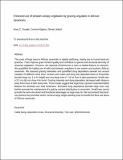Enhanced use of beneath-canopy vegetation by grazing ungulates in African savannahs

View/
Date
2010-12Author
Treydte, Anna C.
Riginos, Corinna
Jeltsch, Florian
Metadata
Show full item recordAbstract
The cover of large trees in African savannahs is rapidly declining, mainly due to human land-use practices. Trees improve grass nutrient quality and contribute to species and structural diversity of savannah vegetation. However, the response of herbivores to trees as habitat features is unknown. We quantified the habitat use of wild and domestic ungulates in two eastern and southern African savannahs. We assessed grazing intensities and quantified dung depositions beneath and around canopies of different sized trees. Grasses were eaten and dung was deposited twice as frequently beneath large (ca. 5 m in height) and very large trees (7–10 m) than in open grasslands. Small trees (<2.5 m) did not show this trend. Grazing intensity and dung deposition decreased with distance away from trees at both study sites. These results suggest that large trees represent essential habitat features for domestic and wild herbivores. Increased dung depositions beneath large trees may further promote the maintenance of a patchy nutrient distribution in savannahs. Small trees cannot provide the same structural and functional advantages as large trees do. We recommend that land- use practices be promoted which conserve large single-standing trees to benefit the flora and fauna of African savannahs.
